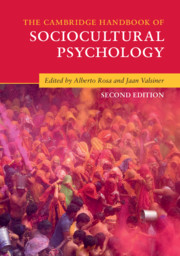Book contents
- The Cambridge Handbook of Sociocultural Psychology
- The Cambridge Handbook of Sociocultural Psychology
- Copyright page
- Contents
- Figures
- Tables
- Contributors
- Editors’ Introduction
- Part I Theoretical and Methodological Issues
- Part II Action, Objects, Artifacts, and Meaning
- Part III The Agent Rises a Reflective Self: Education and Development
- Part IV Institutional Artifacts for Value
- Part V Aesthetic and Religious Experiences
- Part VI Practices and Artifacts for Imagining Identity
- Part VII Experiences Make the Person
- 27 The Human Experience: A Dialogical Account of Self and Feelings
- 28 Knowing Ourselves: Dances of Social Guidance, Imagination, and Development by Overcoming Ambivalence
- 29 Personal History and Historical Selfhood: The Embodied and Pre-reflective Dimension
- 30 The Development of a Person: Children's Experience of Being and Becoming within the Cultural Life Course
- 31 The Construction of the Person in the Interethnic Situation: Dialogues with Indigenous University Students
- 32 Social Identities, Gender, and Self: Cultural Canalization in Imagery Societies
- 33 The Experience of Aging: Views from Without and Within
- General Conclusion
- Index
- References
31 - The Construction of the Person in the Interethnic Situation: Dialogues with Indigenous University Students
from Part VII - Experiences Make the Person
Published online by Cambridge University Press: 25 June 2018
- The Cambridge Handbook of Sociocultural Psychology
- The Cambridge Handbook of Sociocultural Psychology
- Copyright page
- Contents
- Figures
- Tables
- Contributors
- Editors’ Introduction
- Part I Theoretical and Methodological Issues
- Part II Action, Objects, Artifacts, and Meaning
- Part III The Agent Rises a Reflective Self: Education and Development
- Part IV Institutional Artifacts for Value
- Part V Aesthetic and Religious Experiences
- Part VI Practices and Artifacts for Imagining Identity
- Part VII Experiences Make the Person
- 27 The Human Experience: A Dialogical Account of Self and Feelings
- 28 Knowing Ourselves: Dances of Social Guidance, Imagination, and Development by Overcoming Ambivalence
- 29 Personal History and Historical Selfhood: The Embodied and Pre-reflective Dimension
- 30 The Development of a Person: Children's Experience of Being and Becoming within the Cultural Life Course
- 31 The Construction of the Person in the Interethnic Situation: Dialogues with Indigenous University Students
- 32 Social Identities, Gender, and Self: Cultural Canalization in Imagery Societies
- 33 The Experience of Aging: Views from Without and Within
- General Conclusion
- Index
- References
- Type
- Chapter
- Information
- The Cambridge Handbook of Sociocultural Psychology , pp. 575 - 596Publisher: Cambridge University PressPrint publication year: 2018
References
References
Further Reading
- 6
- Cited by

